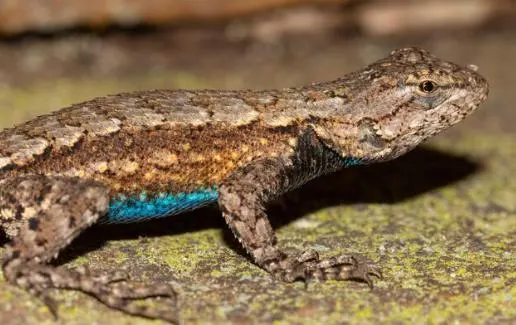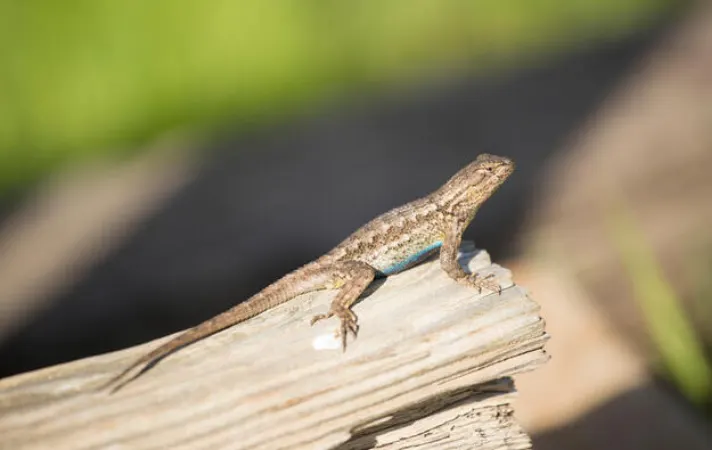The blue belly lizard, also known as the western fence lizard, is a fascinating reptile commonly found in the western United States. Known for its distinctive blue-colored abdomen and the ability to detach its tail to escape predators, this species captivates both casual observers and reptile enthusiasts alike. In this blog post, we will delve into the identification, habitat, diet, and care of the blue belly lizard.

Table of Contents
Scientific Classification
- Kingdom: Animalia
- Phylum: Chordata
- Class: Reptilia
- Order: Squamata
- Family: Phyrnosomatidae
- Genus: Sceloporus
- Scientific Name: Sceloporus occidentalis
Conservation Status
The blue belly lizard is listed as a species of Least Concern, indicating that its population is stable and not currently at risk.
Geographic Distribution
- Locations: Central America, North America
- Specific Range: Western United States, including states like California, Oregon, and Washington, and extending into parts of northern Mexico.
Physical Characteristics
- Color: Brown, grey, yellow, blue, black
- Skin Type: Scales
- Length: 4.3-8.3 inches
- Weight: Approximately 1 ounce
- Lifespan: 5-7 years
- Distinctive Feature: Blue-colored abdomen, particularly pronounced in males
Habitat
Blue belly lizards thrive in various habitats, including grasslands, forests, farmlands, and plains. They prefer environments with ample sunlight and are often seen basking on rocks, logs, and fence posts.
Diet
As carnivores, blue belly lizards primarily consume spiders, insects, and occasionally other small lizards. Their diet helps control the population of pests like beetles, mosquitoes, and grasshoppers.
Reproduction and Life Cycle
The breeding season for blue belly lizards spans from April to July. Males attract females through visual displays, such as push-up movements that showcase their bright blue bellies. Females lay up to three clutches of eggs per season, with each clutch containing 10 to 17 eggs. Hatchlings receive no parental care and must fend for themselves from birth.
Behavioral Traits
Blue belly lizards are ectothermic, relying on external sources of heat to regulate their body temperature. They are solitary creatures, except during the mating season. To escape predators, they can detach their tails, which later regenerate. In colder months, they hibernate in crevices or burrows, reducing their metabolic activity.
Evolution and Origins
The blue belly lizard belongs to a diverse group of reptiles with a long evolutionary history. Their ancestors adapted to various environments, developing specialized abilities for climbing, gliding, and surviving in different habitats.
Predators and Threats
Natural predators of blue belly lizards include coyotes, snakes, bobcats, and hawks. Habitat loss due to human encroachment also poses a significant threat. However, their population remains stable due to their adaptability and defensive mechanisms.
Types of Blue Belly Lizards
There are six recognized subspecies of blue belly lizards:
- Great Basin fence lizard
- Northwestern fence lizard
- Sierra fence lizard
- Coast range fence lizard
- San Joaquin fence lizard
- Island fence lizard
Caring for Blue Belly Lizards as Pets
If you’re considering keeping a blue belly lizard as a pet, here are some tips for proper care:
- Enclosure: A screen-covered aquarium with 10-20 gallons of space.
- Substrate: Use natural substrates like sand, dirt, or cypress mulch.
- Temperature: Provide a heat lamp that produces UVA and UVB rays. Maintain a temperature of 75-85°F, with a basking spot at 90°F.
- Humidity: Mist the enclosure twice a day to maintain appropriate humidity levels.
- Diet: Feed mealworms, wax worms, and crickets three to four times a week. Provide clean drinking water daily.
Q&A Section
Q: Are blue belly lizards poisonous?
A: No, blue belly lizards are not poisonous. However, their bite can be slightly painful.
Q: How can I tell if a blue belly lizard is pregnant?
A: A pregnant female will have a visibly swollen abdomen, typically occurring in the summer.
Q: How do I catch a blue belly lizard?
A: You can catch a blue belly lizard using baited traps or by hand. Approach from behind without casting a shadow, and use a lasso made from sturdy grass to gently ensnare the lizard.
Q: What should I feed a blue belly lizard?
A: Feed them a diet of mealworms, wax worms, and crickets. Ensure they have access to clean drinking water.
Q: Can blue belly lizards be tamed?
A: Blue belly lizards cannot be fully tamed and should be treated as wild animals, even if kept as pets.
Q: Do blue belly lizards carry diseases?
A: While all animals can carry diseases, blue belly lizards have been found to reduce the incidence of Lyme disease in their habitat due to proteins in their blood that kill the bacterium responsible for the disease.
Q: How big do blue belly lizards get?
A: Blue belly lizards typically grow to a length of 4.3-8.3 inches.

Q: How do I take care of a blue belly lizard in captivity?
A: Provide a spacious enclosure with natural substrate, maintain proper temperature and humidity levels, and feed them a diet of mealworms, wax worms, and crickets. Ensure they have access to clean drinking water.
Q: Can blue belly lizards be kept with other lizards?
A: It is not recommended to keep blue belly lizards with other lizards, especially smaller ones, as they can become aggressive.
Q: How do blue belly lizards protect themselves from predators?
A: Blue belly lizards can detach their tails to escape predators. They also have fast reflexes and can quickly climb trees or bushes to evade threats.
The blue belly lizard, with its striking appearance and fascinating behaviors, is a remarkable species worth learning about. Whether you’re observing them in the wild or caring for one as a pet, understanding their needs and characteristics is essential for their well-being. By appreciating and protecting these reptiles, we contribute to the biodiversity and ecological balance of their natural habitats.
- Enchi Ball Python: A Unique and Stunning Morph of Python regius - March 27, 2025
- Emerald Tree Monitor: The Enigmatic Green Guardian of the Rainforest - March 26, 2025
- The Egyptian Cobra (Naja haje): A Fascinating Serpent - March 25, 2025
